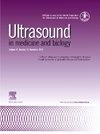High-Frequency Ultrasound Characterization of Periodontal Soft Tissues Pre- and Post-Bacterial Inoculation
IF 2.4
3区 医学
Q2 ACOUSTICS
引用次数: 0
Abstract
Objective
Current diagnostic methods of inflammatory periodontal diseases, e.g., visual evaluation, periodontal probing, and radiographs, are either subjective or insensitive. Intra-oral high-frequency ultrasound was investigated to quantify inflammation by detecting tissue dimensional and perfusion changes.
Methods
A cohort of 15-month-old mini-pigs, 4 female/male each, was analyzed. Pre-molars (PM) 3 and 4, as well as first molars (M1), were scanned. In bi-weekly time intervals all 4 quadrants were randomly enrolled and bacterial injection followed each quadrant scan in a weekly fashion. Soft tissue dimensions were obtained from B-mode images and statistically analyzed to identify correlations to inoculation time, i.e., response to bacterial loading, tooth type and sex, using analysis of variance and regression analysis. Color flow velocity and power-weighted color pixel density was obtained and statistically analyzed analogous to soft tissue.
Results
Soft tissue thickness increased significantly post-inoculation at 1 and 2 mm below the free gingival margin for both genders and all observed teeth. The significance lasted for weeks 2, 4 and 6, except for female M1s (4 weeks). Color flow velocity was significantly higher compared with baseline for 6 weeks, except for male PM4 (2 weeks). Color flow power did not show significance for PM3 and 4, only in M1 (except male week 4). Significance also extended to tooth type and sex.
Conclusion
Periodontal tissue dimension and color flow velocity increased in correlation to bacterial inoculation. Further studies are needed to obtain an understanding of the underlying biology observed here. Eruption of dentition may have been a confounding factor for inflammation interpretation.
细菌接种前后牙周软组织的高频超声特征。
目的:目前炎性牙周病的诊断方法,如视觉评价、牙周探诊和x线片,要么主观,要么不敏感。采用口腔内高频超声,通过检测组织尺寸和灌注变化来量化炎症。方法:选取15月龄小型猪,公母各4头。扫描前磨牙(PM) 3和4,以及第一磨牙(M1)。在每两周的时间间隔内,所有4个象限随机入组,每个象限扫描后每周进行细菌注射。从b型图像中获得软组织尺寸,并通过方差分析和回归分析进行统计分析,以确定接种时间,即对细菌负荷的反应,牙齿类型和性别的相关性。获得颜色流速度和功率加权颜色像素密度,并进行类似于软组织的统计分析。结果:接种后游离龈缘以下1 mm和2 mm的软组织厚度显著增加,性别和所有观察到的牙齿。除雌性m1(4周)外,显著性持续第2、4、6周。除男性PM4(2周)外,6周彩色血流速度显著高于基线。色流功率在PM3和pm4中均无统计学意义,仅在M1中有统计学意义(男性第4周除外)。牙型和性别也有统计学意义。结论:牙周组织尺寸和色流速度与细菌接种有关。需要进一步的研究来了解这里观察到的潜在生物学。牙列的爆发可能是炎症解释的一个混淆因素。
本文章由计算机程序翻译,如有差异,请以英文原文为准。
求助全文
约1分钟内获得全文
求助全文
来源期刊
CiteScore
6.20
自引率
6.90%
发文量
325
审稿时长
70 days
期刊介绍:
Ultrasound in Medicine and Biology is the official journal of the World Federation for Ultrasound in Medicine and Biology. The journal publishes original contributions that demonstrate a novel application of an existing ultrasound technology in clinical diagnostic, interventional and therapeutic applications, new and improved clinical techniques, the physics, engineering and technology of ultrasound in medicine and biology, and the interactions between ultrasound and biological systems, including bioeffects. Papers that simply utilize standard diagnostic ultrasound as a measuring tool will be considered out of scope. Extended critical reviews of subjects of contemporary interest in the field are also published, in addition to occasional editorial articles, clinical and technical notes, book reviews, letters to the editor and a calendar of forthcoming meetings. It is the aim of the journal fully to meet the information and publication requirements of the clinicians, scientists, engineers and other professionals who constitute the biomedical ultrasonic community.

 求助内容:
求助内容: 应助结果提醒方式:
应助结果提醒方式:


